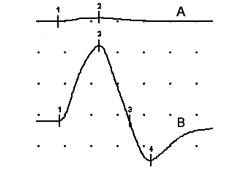Summary
Definition
History and exam
Key diagnostic factors
- history of small cell lung cancer or other malignancy
- history of autoimmune disorder
- history of cigarette smoking
- family history of autoimmune disease
- limb weakness
- dry mouth
- weakness
Other diagnostic factors
- dysarthria
- areflexia
- ptosis
- diplopia
- impotence
- dysphagia
- orthostatic hypotension
- pupillary dilation
- dyspnea
- cerebellar ataxia
Risk factors
- underlying small cell lung cancer or other malignancy
- coexisting autoimmune disorder
- cigarette smoking
- family history of autoimmune disease
Diagnostic tests
1st tests to order
- nerve conduction studies
- low-frequency repetitive nerve stimulation
- anti-P/Q voltage-gated calcium-channel serology
- chest CT scan
- anti-acetylcholine receptor (AChR) serology
- thyroid-stimulating hormone (TSH)
Tests to consider
- serial PFTs
- total-body fluoro-2-deoxyglucose positron emission tomography (FDG-PET) scan
- bronchoscopy
- high-frequency or tetanic repetitive nerve stimulation (RNS)
- single-fiber electromyography
- HLA haplotyping
- antinuclear antibodies (ANA)
- rheumatoid factor (RF)
- antineutrophil cytoplasmic autoantibodies (ANCA)
- B12 and methylmalonic acid (MMA)
Emerging tests
- alpha-1A P/Q voltage-gated calcium-channel subunit antibodies
- anti-SOX1 antibodies
Treatment algorithm
severe respiratory or bulbar weakness
without severe respiratory or bulbar weakness
Contributors
Authors
Jonathan M. Morena, DO
Assistant Professor of Neurology
Duke University Medical Center
Durham
NC
Disclosures
JMM declares that he has no competing interests.
Joshua P. Alpers, MD
Staff Neurologist
University of Tennessee Erlanger Neurology
Chattanooga
TN
Disclosures
JA has been compensated by (1) Alexion, the manufacturer of Soliris and Ultomiris, (2) Argenx, the manufacturer of Vyvgart, and (3) MT Pharma, the manufacturer of Radicava ORS, for participation in advisory boards and speakers bureaus.
Vern C. Juel, MD
Professor of Neurology
Duke University Medical Center
Durham
NC
Disclosures
VCJ declares that he has no competing interests.
Peer reviewers
Olivia Tong, MD
Assistant Clinical Professor
UC Davis Medical Group
CA
Disclosures
OT declares that she has no competing interests.
Zaeem Siddiqui, MD, PhD
Associate Professor
Division of Neurology
University of Alberta
Edmonton
Canada
Disclosures
ZS declares that he has no competing interests.
Paul Wirtz, MD, PhD
Department of Neurology
Haga Hospital
The Hague
The Netherlands
Disclosures
PW is an author of a number of references cited in this topic.
Peer reviewer acknowledgements
BMJ Best Practice topics are updated on a rolling basis in line with developments in evidence and guidance. The peer reviewers listed here have reviewed the content at least once during the history of the topic.
Disclosures
Peer reviewer affiliations and disclosures pertain to the time of the review.
References
Key articles
Titulaer MJ, Lang B, Verschuuren JJ. Lambert-Eaton myasthenic syndrome: from clinical characteristics to therapeutic strategies. Lancet Neurol. 2011 Dec;10(12):1098-107. Abstract
Skeie GO, Apostolski S, Evoli A, et al. Guidelines for treatment of autoimmune neuromuscular transmission disorders. Eur J Neurol. 2010 Jul;17(7):893-902. Abstract
AAEM Quality Assurance Committee, American Association of Electrodiagnostic Medicine. Practice parameter for repetitive nerve stimulation and single fiber EMG evaluation of adults with suspected myasthenia gravis or Lambert-Eaton myasthenic syndrome: summary statement. Muscle Nerve. 2001 Sep;24(9):1236-8.Full text Abstract
Reference articles
A full list of sources referenced in this topic is available to users with access to all of BMJ Best Practice.

Differentials
- Botulism
- Myasthenia gravis
- Myopathy
More DifferentialsGuidelines
- Updated consensus statement: intravenous immunoglobulin in the treatment of neuromuscular disorders report of the AANEM ad hoc committee
- Screening for tumours in paraneoplastic syndromes: report of an EFNS task force
More GuidelinesPatient information
Quitting smoking
More Patient informationLog in or subscribe to access all of BMJ Best Practice
Use of this content is subject to our disclaimer